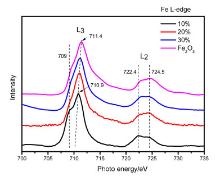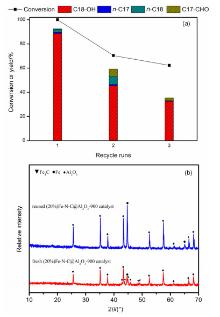有机化学 ›› 2019, Vol. 39 ›› Issue (11): 3258-3263.DOI: 10.6023/cjoc201902031 上一篇 下一篇
研究简报
收稿日期:2019-02-26
发布日期:2019-07-03
通讯作者:
李江
E-mail:lijiang@cup.edu.cn
基金资助:
Li Jianga*( ), Wan Tonga, Zhang Junjiea, Fu Yaob
), Wan Tonga, Zhang Junjiea, Fu Yaob
Received:2019-02-26
Published:2019-07-03
Contact:
Li Jiang
E-mail:lijiang@cup.edu.cn
Supported by:文章分享

长链脂肪酸是一种重要的生物质原料,其氢化制备的脂肪醇由于用途广泛以及市场价值不断增长,近年来引起了人们的广泛关注.报道了一例使用非均相铁催化硬脂酸选择性加氢制备硬脂醇的实例.与其他非贵金属元素(如钴和镍)相比,铁在地壳中的丰度高出3000~30000倍,价格仅为20~150分之一,因此该方法更经济,更有吸引力.催化剂是通过将铁和氮掺杂碳前驱体同时热解到氧化铝载体上制备的.制备催化剂时最佳热解温度为900℃,最佳铁的质量分数为20%.反应最佳反应温度为320℃,最佳氢气压力为4 MPa.产物随时间分布曲线表明硬脂酸在0.5 h内迅速转化为硬脂醇,收率为88.6%.4 h后逐渐转化为十八烷,收率为90%.
李江, 万童, 张俊杰, 傅尧. 铁催化硬脂酸选择性氢化制硬脂醇[J]. 有机化学, 2019, 39(11): 3258-3263.
Li Jiang, Wan Tong, Zhang Junjie, Fu Yao. Iron-Catalyzed Selective Hydrogenation of Stearic Acid to Stearyl Alcohol[J]. Chinese Journal of Organic Chemistry, 2019, 39(11): 3258-3263.
 | |||||||
| Entry | Catalyst | Conv./% | Yield b/% | Carbon balance | |||
| C18-OH | C17 | C18 | C17-CHO | ||||
| 1 | — | 33.3 | 0.5 | 0.5 | 0.1 | 0.2 | 3.9 |
| 2 | 20% Fe-N-C@Al2O3-900 | >99 | 88.6 | 1.1 | 2.4 | 0.4 | 92.5 |
| 3 | 20% Fe-Al2O3-900 | 21.6 | 0.9 | 0.9 | 0.1 | 2.2 | 19.0 |
| 4 | N-C@Al2O3-900 | 42.3 | 0.5 | 0.5 | 0.4 | 0.4 | 4.3 |
| 5 | Al2O3 | 43.3 | 7.9 | 1.0 | 0.9 | 4.1 | 32.1 |
| 6 | 20% Fe-N-C@Al2O3-550 | 98.3 | 80.4 | 1.5 | 14.3 | 0 | 97.9 |
| 7 | 20% Fe-N-C@Al2O3-700 | 95.7 | 34.1 | 0.7 | 3.8 | 3.0 | 43.5 |
| 8 | 20% Fe-N-C@Al2O3-1100 | 97.1 | 47.9 | 1.6 | 11.8 | 2.6 | 65.8 |
| 9 | 20% Fe-N-C@SiO2-900 | 88.5 | 1.0 | 1.3 | 0.1 | 1.1 | 4.0 |
| 10 | 20% Fe-N-C-900 | 92.1 | 4.3 | 1.6 | 0.7 | 1.8 | 9.1 |
| 11 | 20% Fe-N-C@TiO2-900 | 66.9 | 3.6 | 0.9 | 0.4 | 3.0 | 11.8 |
| 12 | 20% Fe(NO3)3-N-C@Al2O3-900 | 80.6 | 10.8 | 1.2 | 0.6 | 2.2 | 18.4 |
| 13 | 20% Fe-phen-C@Al2O3-900 | 96.2 | 58.8 | 0.9 | 4.4 | 3.5 | 70.3 |
| 14 | 3% Fe-N-C@Al2O3-900 | 89.4 | 52.6 | 1.0 | 1.1 | 2.9 | 64.4 |
| 15 | 5% Fe-N-C@Al2O3-900 | 94.7 | 21.6 | 0.6 | 0.8 | 3.9 | 28.4 |
| 16 | 10% Fe-N-C@Al2O3-900 | 98.0 | 62.0 | 0.6 | 0.6 | 1.8 | 66.3 |
| 17 | 30% Fe-N-C@Al2O3-900 | 99.3 | 46.0 | 0.8 | 1.5 | 2.2 | 50.9 |
 | |||||||
| Entry | Catalyst | Conv./% | Yield b/% | Carbon balance | |||
| C18-OH | C17 | C18 | C17-CHO | ||||
| 1 | — | 33.3 | 0.5 | 0.5 | 0.1 | 0.2 | 3.9 |
| 2 | 20% Fe-N-C@Al2O3-900 | >99 | 88.6 | 1.1 | 2.4 | 0.4 | 92.5 |
| 3 | 20% Fe-Al2O3-900 | 21.6 | 0.9 | 0.9 | 0.1 | 2.2 | 19.0 |
| 4 | N-C@Al2O3-900 | 42.3 | 0.5 | 0.5 | 0.4 | 0.4 | 4.3 |
| 5 | Al2O3 | 43.3 | 7.9 | 1.0 | 0.9 | 4.1 | 32.1 |
| 6 | 20% Fe-N-C@Al2O3-550 | 98.3 | 80.4 | 1.5 | 14.3 | 0 | 97.9 |
| 7 | 20% Fe-N-C@Al2O3-700 | 95.7 | 34.1 | 0.7 | 3.8 | 3.0 | 43.5 |
| 8 | 20% Fe-N-C@Al2O3-1100 | 97.1 | 47.9 | 1.6 | 11.8 | 2.6 | 65.8 |
| 9 | 20% Fe-N-C@SiO2-900 | 88.5 | 1.0 | 1.3 | 0.1 | 1.1 | 4.0 |
| 10 | 20% Fe-N-C-900 | 92.1 | 4.3 | 1.6 | 0.7 | 1.8 | 9.1 |
| 11 | 20% Fe-N-C@TiO2-900 | 66.9 | 3.6 | 0.9 | 0.4 | 3.0 | 11.8 |
| 12 | 20% Fe(NO3)3-N-C@Al2O3-900 | 80.6 | 10.8 | 1.2 | 0.6 | 2.2 | 18.4 |
| 13 | 20% Fe-phen-C@Al2O3-900 | 96.2 | 58.8 | 0.9 | 4.4 | 3.5 | 70.3 |
| 14 | 3% Fe-N-C@Al2O3-900 | 89.4 | 52.6 | 1.0 | 1.1 | 2.9 | 64.4 |
| 15 | 5% Fe-N-C@Al2O3-900 | 94.7 | 21.6 | 0.6 | 0.8 | 3.9 | 28.4 |
| 16 | 10% Fe-N-C@Al2O3-900 | 98.0 | 62.0 | 0.6 | 0.6 | 1.8 | 66.3 |
| 17 | 30% Fe-N-C@Al2O3-900 | 99.3 | 46.0 | 0.8 | 1.5 | 2.2 | 50.9 |






| [1] |
Huber G. W. Iborra S. Corma A. Chem. Rev. 2006 106 4044.
doi: 10.1021/cr068360d |
| [2] |
Corma A. Iborra S. Velty A. Chem. Rev. 2007 107 2411.
doi: 10.1021/cr050989d |
| [3] |
Yang Z. Fu Y. Guo Q. Chin. J. Org. Chem. 2015 35 273.
doi: 10.6023/cjoc201409012 |
|
杨 珍 傅 尧 郭 庆祥 有机化学 2015 35 273.
doi: 10.6023/cjoc201409012 |
|
| [4] |
Jamil F. Al-Haj L. Al-Muhtaseb A. H. Al-Hinai M. A. Baawain M. Rashid U. Ahmad M. N. M. Rev. Chem. Eng. 2018 34 267.
doi: 10.1515/revce-2016-0026 |
| [5] | Besson, M.; Gallezot, P.; Pinel, C. Chem. Rev. 2014, 114, 1827. |
| [6] | Gupta S. Frost and Sullivan Market Insight 2004 11075449. |
| [7] |
Adkins H. Folkers K. J. Am. Chem. Soc. 1931 53 1095.
doi: 10.1021/ja01354a042 |
| [8] |
Toba M. Tanaka S.-I. Niwa S.-I. Mizukami F. Koppány Z. Guczi L. Cheah K.-Y. Tang T.-S. Appl. Catal., A 1999 189 243.
doi: 10.1016/S0926-860X(99)00281-1 |
| [9] |
Mendes M. Santos O. Jordao E. Silva A. Appl. Catal., A 2001 217 253.
doi: 10.1016/S0926-860X(01)00613-5 |
| [10] |
Takeda Y. Nakagawa Y. Tomishige K. Catal. Sci. Technol. 2012 2 2221.
doi: 10.1039/c2cy20302b |
| [11] |
Takeda Y. Tamura M. Nakagawa Y. Okumura K. Tomishige K. ACS Catal. 2015 5 7034.
doi: 10.1021/acscatal.5b01054 |
| [12] |
Ullrich J. Breit B. ACS Catal. 2018 8 785.
doi: 10.1021/acscatal.7b03484 |
| [13] |
Manyar H. G. Paun C. Pilus R. Rooney D. W. Thompson J. M. Hardacre C. Chem. Commun. 2010 46 6279.
doi: 10.1039/c0cc01365j |
| [14] |
Rozmysłowicz B. Kirilin A. Aho A. Manyar H. Hardacre C. Wärn J. Salmi T. Murzin D. Y. J. Catalysis 2015 328 197.
doi: 10.1016/j.jcat.2015.01.003 |
| [15] |
Toyao T. Siddiki S. M. Touchy A. S. Onodera W. Kon K. Morita Y. Kamachi T. Yoshizawa K. Shimizu K. I. Chem.-Eur. J. 2017 23 1001.
doi: 10.1002/chem.201604762 |
| [16] |
Kandel K. Chaudhary U. Nelson N. C. Slowing I. I. ACS Catal. 2015 5 6719.
doi: 10.1021/acscatal.5b01664 |
| [17] |
Wu L. Li L. Li B. Zhao C. Chem. Commun. 2017 53 6152.
doi: 10.1039/C7CC01126A |
| [18] |
Onyestyák G. Harnos S. Kalló D. Catal. Commun. 2011 16 184.
doi: 10.1016/j.catcom.2011.09.032 |
| [19] |
Gao X. Tong D. Zhong H. Jin B. Jin F. Zhang H. RSC Adv. 2016 6 27623.
doi: 10.1039/C6RA01150K |
| [20] |
Kong X. Fang Z. Bao X. Wang Z. Mao S. Wang Y. J. Catalysis 2018 367 139.
doi: 10.1016/j.jcat.2018.08.022 |
| [21] |
Jia W. Xu G. Liu X. Zhou F. Ma H. Zhang Y. Fu Y. Energy Fuels 2018 32 8438.
doi: 10.1021/acs.energyfuels.8b01114 |
| [22] |
Song S. Wang D. Di L. Wang C. Dai W. Wu G. Guan N. Li L. Chin. J. Catal. 2018 39 250.
doi: 10.1016/S1872-2067(17)63003-1 |
| [23] |
Li J. Zhang J. Wang S. Xu G. Wang H. Vlachos D. G. ACS Catal. 2019 9 1564.
doi: 10.1021/acscatal.8b04967 |
| [24] |
Jagadeesh R. V. Surkus A. Junge H. Pohl M. Radnik J. Rabeah J. Huan H. Schunemann V. Bruckner A. Beller M. Science 2013 342 1073.
doi: 10.1126/science.1242005 |
| [25] |
Cui X. Li Y. Bachmann S. Scalone M. Surkus A. Junge K. Topf C. Beller M. J. Am. Chem. Soc. 2015 137 10652.
doi: 10.1021/jacs.5b05674 |
| [26] |
Natte K. Neumann H. Jagadeesh R. V. Beller M. Nat. Commun. 2017 8 1344.
doi: 10.1038/s41467-017-01428-0 |
| [27] |
Li J. Liu J. Zhou H. Fu Y. ChemSusChem 2016 9 1339.
doi: 10.1002/cssc.201600089 |
| [28] |
Li J. Liu J. Liu H. Xu G. Zhang J. Liu J. Zhou G. Li Q. Xu Z. Fu Y. ChemSusChem 2017 10 1436.
doi: 10.1002/cssc.201700105 |
| [29] |
Li J. Zhang J. Liu H. Liu J. Xu G. Liu J. Sun H. Fu Y. ChemistrySelect 2017 2 11062.
doi: 10.1002/slct.201701966 |
| [30] |
Li J. Sun H. Liu J. X. Zhang J. J. Li Z. X. Fu Y. Mol. Catal. 2018 452 36.
doi: 10.1016/j.mcat.2018.03.014 |
| [31] |
Leveneur J. Waterhouse G. I. N. Kennedy J. Metson J. B. Mitchell D. R. G. J. Phys. Chem. C 2011 115 20978.
doi: 10.1021/jp206357c |
| [1] | 周章涛, 王杨, 程冰心, 叶伟平. [RuCl(p-cymene)-(S)-BINAP]Cl催化不对称合成反式-3-氨基-双环[2.2.2]辛烷-2-甲酸乙酯[J]. 有机化学, 2023, 43(8): 2961-2967. |
| [2] | 陈乡萍, 孟晨湘, 李梦娜, 楚尚敏, 朱欣欣, 许凯, 刘澜涛, 王涛, 张凤华, 李飞. 水相中抗坏血酸钠促进铁催化合成含硫芳香伯胺化合物[J]. 有机化学, 2023, 43(8): 2800-2807. |
| [3] | 陈新强, 张敬. 伯醇的脱羟甲基反应的研究进展[J]. 有机化学, 2023, 43(8): 2711-2719. |
| [4] | 王莎, 陈常鹏, 曾小明. 联吡啶配体促进铬催化炔烃的顺式硼氢化反应[J]. 有机化学, 2023, 43(7): 2447-2453. |
| [5] | 左鑫, 许诗诺, 陈忠洋, 鄢剑锋, 袁耀锋. 茂铁类单分子结电子传输性质的研究进展[J]. 有机化学, 2023, 43(7): 2313-2322. |
| [6] | 宋姿洁, 刘俊, 白赢, 厉嘉云, 彭家建. 利用硅氢加成反应催化转化二氧化碳研究进展[J]. 有机化学, 2023, 43(6): 2068-2080. |
| [7] | 卢凯, 屈浩琦, 陈樨, 秋慧, 郑晶, 马猛涛. 无催化剂、无溶剂条件下炔烃和烯烃与儿茶酚硼烷的硼氢化反应[J]. 有机化学, 2023, 43(6): 2197-2205. |
| [8] | 褚杨杨, 韩召斌, 丁奎岭. 动力学拆分在过渡金属催化的不对称(转移)氢化中的应用研究[J]. 有机化学, 2023, 43(6): 1934-1951. |
| [9] | 刘育园, 雷雅钦, 杨文, 赵万祥. 钴催化烯胺远程硼氢化[J]. 有机化学, 2023, 43(5): 1761-1771. |
| [10] | 李思达, 舒兴中, 吴立朋. 锆、钛介导的烯烃、炔烃硼氢化[J]. 有机化学, 2023, 43(5): 1751-1760. |
| [11] | 刘双, 邹亮华, 王晓明. 均相钴催化氨硼烷的脱氢及转移氢化反应的研究进展[J]. 有机化学, 2023, 43(5): 1713-1725. |
| [12] | 窦谦, 汪太民, 房丽晶, 翟宏斌, 程斌. 光诱导铁催化在有机合成中的应用研究进展[J]. 有机化学, 2023, 43(4): 1386-1415. |
| [13] | 党燕, 贾朝红, 王亚兰, 王丽, 李亚飞, 李亚红. 含吡咯基配体的锌、锂和镁配合物的合成与表征及其对芳基碘代物的硼化反应和醛、酮的硼氢化反应的催化作用[J]. 有机化学, 2023, 43(3): 1124-1135. |
| [14] | 孙伟, 朱守非. 铁系金属催化烯烃与三级硅烷的硅氢化反应研究进展[J]. 有机化学, 2023, 43(10): 3339-3351. |
| [15] | 冯向青, 杜海峰. B(C6F5)3催化不饱和烃的硅化反应[J]. 有机化学, 2023, 43(10): 3544-3557. |
| 阅读次数 | ||||||
|
全文 |
|
|||||
|
摘要 |
|
|||||